An Innovative Dynamic Model for Predicting Typhoon Track Deflections over Complex Terrain
Abstract
1. Introduction
1.1. Research Background
1.2. Mechanisms Influencing Typhoon Track over Complex Terrain
1.3. Research Methods in Typhoon Track Studies over Topography
1.4. Objectives of the Study
2. A Dynamic Model for Strong Cyclonic Vortex Motion over Topography
2.1. Governing Equations and Approximations
2.2. Point Vortex Model and Meridional Adjusting Velocity (MAV)
2.3. Finite Vortex Correction and Final Model
2.4. Physical Interpretation of the Dynamic Model
3. Analysis of a Typhoon-like Vortex Path over Isolated Topography
3.1. Experiment Setup
3.1.1. Idealized Topography Settings
3.1.2. Typhoon-like Vortex Initialization
3.1.3. Definition of Impinging Angle and Track Deflection
3.2. Track Analysis of Vortex M with Varying Impinging Angles and Landing Positions
3.2.1. Visualization of Vortex Tracks and Deflections
3.2.2. Impact of Landing Position on Track Deflection
3.2.3. Impact of Impinging Angle on Track Curvature
3.2.4. Summary of Results
4. Analysis of Typhoon-like Vortex Path over Taiwan Topography
4.1. Analysis of Taiwan Island Topography: General Trends and Cross-Sectional Characteristics
4.2. Influence of Vortex Intensity on Track Deflection with Fixed Impinging Angle of 195°
4.3. Influence of Vortex Intensity on Track Deflection with Fixed Impinging Angle of 170°
4.4. Influence of Vortex Intensity on Track Deflection with Fixed Impinging Angle of 145°
4.5. Influence of Vortex Intensity on Track Deflection with Fixed Impinging Angle of 120°
4.6. A Comprehensive Analysis with Real and Idealized Terrain
- Influence of Vortex Intensity (): Across all figures, stronger vortices (e.g., S3) exhibit the most pronounced S-shaped track deflections. These deflections occur due to larger topographic adjusting parameters (), leading to significant MAV. The MAV is directly influenced by , where positive values correspond to compression on windward slopes, driving southward deflections, and negative values correspond to stretching on leeward slopes, causing northward corrections. Weaker vortices (e.g., S1) show minimal interaction, maintaining relatively straight paths due to subdued MAV responses.
- Effect of Impinging Angle (): The impinging angle significantly alters the extent of interaction between the vortex and the terrain. Steeper impinging angles (e.g., 120° in Figure 6d–f) result in greater path curvature as the vortex spends more time engaging with the terrain. In contrast, shallower angles (e.g., 195° in Figure 5a–c) lead to less interaction, as the vortices traverse the terrain more perpendicularly, minimizing prolonged exposure to the topographic gradients.
- Path Characteristics: The distinct S-shaped patterns observed in S3 are most evident under steeper impinging angles (Figure 6e,f). These figures show the dynamic response to terrain, characterized by strong deflections due to amplified MAV effects. Conversely, weaker vortices like S1 maintain near-linear paths across all angles, demonstrating that lower values dampen the influence of topographic variations.
- The presence of “S-shaped curves” in typhoon tracks interacting with terrain, characterized by significant southward and subsequent northward deflections, is a recognized phenomenon in both observations and numerical simulations. As noted previously, real typhoons like Herb (1996) and Soudelor (2015) showcase these S-shaped tracks. Numerical studies, including [11,14,17], consistently demonstrate these deflections in their simulations of typhoons interacting with the CMR. The varying degrees of curvature observed in these tracks depend on factors like the vortex intensity, the terrain’s steepness, and, importantly, the impinging angle.
- The relationship between the impinging angle and path curvature, as supported by the idealized simulations, probably finds backing in the work of Lin and Savage [16] and the studies it builds upon [7,14]. Specifically, Lin and Savage [16] show that shallower approach angles (smaller γ) lead to more pronounced deflections and a higher likelihood of track discontinuity due to increased vorticity stretching on the lee side. While not explicitly quantifying curvature, their categorization of track types (E, N, S, NE, SE) based on landfall and approach angle implicitly acknowledges the connection between shallower angles and greater deviations from the initial track, which often manifests as increased curvature. Therefore, while further research could quantify this relationship more precisely, the existing literature, including the work of Lin and Savage [16], supports the connection between shallower approach angles and increased path curvature in typhoon–terrain interactions.
4.7. Dynamic Model Validation: A Comparative Analysis of Simulated and Observed Typhoon Soudelor (2015) Tracks
4.7.1. Initial Condition Settings of Dynamic Model
4.7.2. Comparing Simulated and Observed Tracks of Typhoon Soudelor (2015)
- Windward Ascent and Southward Deflection: As Soudelor ascends the windward slopes, () increases, leading to a strong positive MAV and the observed southward deflection. The magnitude of this deflection is consistent with the steep terrain encountered during landfall near Hualien, as illustrated in the elevational profile in Figure 7b.
- Leeward Descent and Northward Adjustment: Upon reaching the leeward side, the decrease in () weakens the positive MAV, allowing the track to gradually adjust northward, as seen in both the simulated and observed tracks.
- Discrepancy over the Central Mountains: The deviation between the simulated and observed tracks over the highest terrain likely arises from the model’s simplified representation of the vortex. Factors like terrain friction and diabatic effects, absent in the model, become more significant over high mountains, contributing to the observed track differences.
- Improved Agreement After Mountain Crossing: The improved agreement between the tracks after crossing the mountains suggests that the dynamic model captures the essential topographic steering mechanisms once the vortex moves away from the most complex terrain.
5. Conclusions
5.1. A Novel Dynamic Model for Predicting Typhoon Tracks over Complex Terrain
5.2. Evaluating Model Performance with Idealized Topography
5.3. Applying the Model to Real-World Complexity: Typhoon-like Tracks over Taiwan
5.4. Key Findings and Implications for Typhoon Track Forecasting
5.4.1. Key Findings
- Influence of vortex intensity: Stronger vortices experience more pronounced deflections due to their enhanced sensitivity to topographic steering (larger α and MAV). This highlights the importance of accurately estimating and forecasting vortex intensity for reliable track prediction.
- Impact of approach angle: Shallower approach angles amplify deflections due to prolonged interaction with steep terrain. This finding emphasizes the need to carefully consider the vortex’s initial trajectory and its orientation relative to topographic features.
- North-south asymmetry in deflections: The significant difference in track deflections observed north and south of the CMR demonstrates the importance of capturing detailed topographic features to accurately predict track deviations.
- Enhanced track variability in complex terrain: The increased variability in typhoon tracks simulated over Taiwan’s complex topography, compared to idealized terrain, underscores the model’s ability to capture the dynamic interplay between a vortex and its environment, a crucial aspect for realistic track forecasting.
- Real-world validation with historical Typhoon: The model’s application to Typhoon Soudelor (2015) provided a crucial real-world test of its capabilities. The model successfully reproduced the observed southward deflection induced by the CMR, demonstrating the influence of steep terrain gradients and the resulting MAV on the typhoon’s trajectory. While minor discrepancies were noted, particularly over the highest terrain where simplified model physics likely played a role, the overall agreement between the simulated and observed tracks, especially after mountain crossing, highlights the model’s skill in capturing the dominant topographic steering effects. This successful real-world application reinforces the model’s potential for improving typhoon track forecasting and contributing to enhanced disaster preparedness strategies.
- The study confirms that vortex intensity and structural attributes are critical in determining the extent of interaction with topography, as shown in other studies [17,40]. Stronger vortices exhibit more pronounced track deflections due to heightened sensitivity to terrain, consistent with the amplified deflection patterns modeled here. This finding is further substantiated by idealized simulations and real-case observations that emphasize intensity’s role in altering track dynamics across steep terrains like the CMR.
5.4.2. Implications and Future Directions
- Real-world model validation and future applications: The successful application of the model to Typhoon Soudelor provides a strong foundation for future research and development. The model’s ability to capture the key features of Soudelor’s track, including the southward deflection and subsequent northwestward turn, highlights its potential for real-time forecasting applications. Future studies should focus on refining the model by incorporating more complex physical processes, such as terrain friction and diabatic effects, to further improve its accuracy, particularly in regions of high terrain. Furthermore, applying the model to other typhoon cases and geographical locations with complex terrain will provide valuable insights into its broader applicability and contribute to the development of more robust and geographically diverse typhoon track prediction systems.
- This study’s model can serve as a foundational tool for ensemble forecasting and real-time applications, particularly for regions with complex terrain. The success in replicating Soudelor’s track highlights the potential for further validation in diverse geographical regions with similar topographical challenges, as suggested by other studies [11,21] that discuss terrain-sensitive vortex behavior and underscore the need for accurate terrain representation in track forecasting models.
Funding
Institutional Review Board Statement
Informed Consent Statement
Data Availability Statement
Acknowledgments
Conflicts of Interest
References
- Kepert, J.D. Tropical Cyclone Structure and Dynamics. In World Scientific Series on Asia-Pacific Weather and Climate; World Scientific: Singapore, 2010; Volume 4, pp. 3–53. ISBN 978-981-4293-47-1. [Google Scholar]
- Lin, Y.-L. Mesoscale Dynamics, 1st ed.; Cambridge University Press: Cambridge, UK, 2007; ISBN 978-0-521-00484-8. [Google Scholar]
- Wu, C.-C.; Kuo, Y.-H. Typhoons Affecting Taiwan: Current Understanding and Future Challenges. Bull. Amer. Meteor. Soc. 1999, 80, 67–80. [Google Scholar] [CrossRef]
- Hsu, L.-H.; Su, S.-H.; Fovell, R.G.; Kuo, H.-C. On Typhoon Track Deflections near the East Coast of Taiwan. Mon. Wea. Rev. 2018, 146, 1495–1510. [Google Scholar] [CrossRef]
- Shieh, S.L.; Wang, S.T.; Cheng, M.D.; Yeh, T.C. Tropical Cyclone Tracks over Taiwan and Its Vicinity for the One Hundred Years 1897 to 1996; Central Weather Bureau: Taipei, Taiwan, 1998; p. 497. [Google Scholar]
- Wang, S.T. An Integrated Study of the Impact of the Orography in Taiwan on the Movement, Intensity, Structure, Wind and Rainfall Distribution of Invading Typhoons; Chinese National Science Council: Taipei, Taiwan, 1992; p. 285. [Google Scholar]
- Yeh, T.-C.; Elsberry, R.L. Interaction of Typhoons with the Taiwan Orography. Part I: Upstream Track Deflections. Mon. Wea. Rev. 1993, 121, 3193–3212. [Google Scholar] [CrossRef]
- Yeh, T.-C.; Elsberry, R.L. Interaction of Typhoons with the Taiwan Orography. Part II: Continuous and Discontinuous Tracks across the Island. Mon. Wea. Rev. 1993, 121, 3213–3233. [Google Scholar] [CrossRef]
- Jian, G.-J.; Teng, J.-H.; Wang, S.-T.; Cheng, M.-D.; Cheng, C.-P.; Chen, J.-H.; Chu, Y.-J. An Overview of the Tropical Cyclone Database at the Central Weather Bureau of Taiwan. Terr. Atmos. Ocean. Sci. 2022, 33, 26. [Google Scholar] [CrossRef]
- Peng, L.; Wang, S.-T.; Shieh, S.-L.; Cheng, M.-D.; Yeh, T.-C. Surface Track Discontinuity of Tropical Cyclones Crossing Taiwan: A Statistical Study. Mon. Weather. Rev. 2012, 140, 121–139. [Google Scholar] [CrossRef]
- Huang, K.-C.; Wu, C.-C. The Impact of Idealized Terrain on Upstream Tropical Cyclone Track. J. Atmos. Sci. 2018, 75, 3887–3910. [Google Scholar] [CrossRef]
- Huang, Y.-H.; Wu, C.-C.; Wang, Y. The Influence of Island Topography on Typhoon Track Deflection. Mon. Weather. Rev. 2011, 139, 1708–1727. [Google Scholar] [CrossRef]
- Gong, Y.; Li, Y.; Zhang, D.-L. A Statistical Study of Unusual Tracks of Tropical Cyclones near Taiwan Island. J. Appl. Meteorol. Climatol. 2018, 57, 193–206. [Google Scholar] [CrossRef]
- Lin, Y.-L.; Chen, S.-Y.; Hill, C.M.; Huang, C.-Y. Control Parameters for the Influence of a Mesoscale Mountain Range on Cyclone Track Continuity and Deflection. J. Atmos. Sci. 2005, 62, 1849–1866. [Google Scholar] [CrossRef]
- Liu, L.; Lin, Y.-L.; Chen, S.-H. Effects of Landfall Location and Approach Angle of an Idealized Tropical Cyclone over a Long Mountain Range. Front. Earth Sci. 2016, 4, 14. [Google Scholar] [CrossRef]
- Lin, Y.-L.; Savage, L.C. Effects of Landfall Location and the Approach Angle of a Cyclone Vortex Encountering a Mesoscale Mountain Range. J. Atmos. Sci. 2011, 68, 2095–2106. [Google Scholar] [CrossRef]
- Tang, C.K.; Chan, J.C.L. Idealized Simulations of the Effect of Taiwan and Philippines Topographies on Tropical Cyclone Tracks. Quart. J. Royal Meteoro. Soc. 2014, 140, 1578–1589. [Google Scholar] [CrossRef]
- Tang, C.K.; Chan, J.C.L. Idealized Simulations of the Effect of Taiwan Topography on the Tracks of Tropical Cyclones with Different Sizes. Quart. J. Royal Meteoro. Soc. 2016, 142, 793–804. [Google Scholar] [CrossRef]
- Hsu, L.-H.; Kuo, H.-C.; Fovell, R.G. On the Geographic Asymmetry of Typhoon Translation Speed across the Mountainous Island of Taiwan. J. Atmos. Sci. 2013, 70, 1006–1022. [Google Scholar] [CrossRef]
- Huang, C.-Y.; Chen, C.-A.; Chen, S.-H.; Nolan, D.S. On the Upstream Track Deflection of Tropical Cyclones Past a Mountain Range: Idealized Experiments. J. Atmos. Sci. 2016, 73, 3157–3180. [Google Scholar] [CrossRef]
- Lin, Y.-L.; Han, J.; Hamilton, D.W.; Huang, C.-Y. Orographic Influence on a Drifting Cyclone. J. Atmos. Sci. 1999, 56, 534–562. [Google Scholar] [CrossRef]
- Lin, Y.-L.; Chen, S.-H.; Liu, L. Orographic Influence on Basic Flow and Cyclone Circulation and Their Impacts on Track Deflection of an Idealized Tropical Cyclone. J. Atmos. Sci. 2016, 73, 3951–3974. [Google Scholar] [CrossRef]
- Yeh, T.-C.; Hsiao, L.-F.; Chen, D.-S.; Huang, K.-N. A Study on Terrain-Induced Tropical Cyclone Looping in East Taiwan: Case Study of Typhoon Haitang in 2005. Nat. Hazards 2012, 63, 1497–1514. [Google Scholar] [CrossRef][Green Version]
- Wu, C.-C.; Li, T.-H.; Huang, Y.-H. Influence of Mesoscale Topography on Tropical Cyclone Tracks: Further Examination of the Channeling Effect. J. Atmos. Sci. 2015, 72, 3032–3050. [Google Scholar] [CrossRef]
- Bender, M.A.; Tuleya, R.E.; Kurihara, Y. A Numerical Study of the Effect of Island Terrain on Tropical Cyclones. Mon. Wea. Rev. 1987, 115, 130–155. [Google Scholar] [CrossRef]
- Lin, Y.-L.; Ensley, D.B.; Chiao, S.; Huang, C.-Y. Orographic Influences on Rainfall and Track Deflection Associated with the Passage of a Tropical Cyclone. Mon. Wea. Rev. 2002, 130, 2929–2950. [Google Scholar] [CrossRef]
- Wei-Jen Chang, S. The Orographic Effects Induced by an Island Mountain Range on Propagating Tropical Cyclones. Mon. Wea. Rev. 1982, 110, 1255–1270. [Google Scholar] [CrossRef]
- Chan, J.C.L.; Ko, F.M.F.; Lei, Y.M. Relationship between Potential Vorticity Tendency and Tropical Cyclone Motion. J. Atmos. Sci. 2002, 59, 1317–1336. [Google Scholar] [CrossRef]
- Schär, C.; Smith, R.B. Shallow-Water Flow Past Isolated Topography. Part II: Transition to Vortex Shedding. J. Atmos. Sci. 1993, 50, 1401–1412. [Google Scholar] [CrossRef]
- Adem, J. A Series Solution for the Barotropic Vorticity Equation and Its Application in the Study of Atmospheric Vortices. Tellus 1956, 8, 364–372. [Google Scholar] [CrossRef]
- Carnevale, G.F.; Kloosterziel, R.C.; Van Heijst, G.J.F. Propagation of Barotropic Vortices over Topography in a Rotating Tank. J. Fluid Mech. 1991, 233, 119–139. [Google Scholar] [CrossRef]
- Chan, J.C.L. The Physics of Tropical Cyclone motion. Annu. Rev. Fluid Mech. 2005, 37, 99–128. [Google Scholar] [CrossRef]
- Fiorino, M.; Elsberry, R.L. Some Aspects of Vortex Structure Related to Tropical Cyclone Motion. J. Atmos. Sci. 1989, 46, 975–990. [Google Scholar] [CrossRef]
- Chan, J.C.L.; Williams, R.T. Analytical and Numerical Studies of the Beta-Effect in Tropical Cyclone Motion. Part I: Zero Mean Flow. J. Atmos. Sci. 1987, 44, 1257–1265. [Google Scholar] [CrossRef]
- Holland, G.J. An Analytic Model of the Wind and Pressure Profiles in Hurricanes. Mon. Wea. Rev. 1980, 108, 1212–1218. [Google Scholar] [CrossRef]
- Brand, S.; Blelloch, J.W. Changes in the Characteristics of Typhoons Crossing the Island of Taiwan. Mon. Wea. Rev. 1974, 102, 708–713. [Google Scholar] [CrossRef]
- Chen, H.-C. Interaction of Barotropic Vortices over Topography Based on Similarity Laws: Rotating Tank Experiment and Shallow-Water Simulation. Arab. J. Geosci. 2022, 15, 276. [Google Scholar] [CrossRef]
- Chen, H.-C.; Chu, C.-C.; Chang, C.-C. A Dynamic Model for Strong Vortices over Topography on a β Plane. In Advances in Engineering Mechanics—Reflections and Outlooks; World Scientific: Vancouver, BC, Canada, 2005; pp. 669–680. [Google Scholar]
- Chen, H.-C. Sensitivity Analysis of Strong Cyclone Track Deflection over Isolated Topography: Exploring the Impact of Vortex Impinging Direction and Strength. In Proceedings of the ECAS 2023, Online, 15–30 October 2023; MDPI: Basel, Switzerland, 2023; p. 1. [Google Scholar]
- Kuo, H.-C.; Williams, R.T.; Chen, J.-H.; Chen, Y.-L. Topographic Effects on Barotropic Vortex Motion: No Mean Flow. J. Atmos. Sci. 2001, 58, 1310–1327. [Google Scholar] [CrossRef]
- Chen, H.-C.; Leu, J.-H.; Liu, Y.; Xie, H.-S.; Chen, Q. A Validated Study of a Modified Shallow Water Model for Strong Cyclonic Motions and Their Structures in a Rotating Tank. Math. Probl. Eng. 2021, 2021, 5529601. [Google Scholar] [CrossRef]
- Masuda, A.; Marubayashi, K.; Ishibashi, M. A Laboratory Experiment and Numerical Simulation of an Isolated Barotropic Eddy in a Basin with Topographic β. J. Fluid Mech. 1990, 213, 641. [Google Scholar] [CrossRef]
- Chen, H.-C.; Leu, J.-H.; Lin, Y.-L.; Liu, H.-P.; Huang, C.-L.; Chen, H.-S.; Lan, T.-S. Cyclonic Motion and Structure in Rotating Tank: Experiment and Theoretical Analysis. Sens. Mater. 2021, 33, 2385. [Google Scholar] [CrossRef]
- Pedlosky, J. Geophysical Fluid Dynamics; Springer New York: New York, NY, USA, 1987; ISBN 978-0-387-96387-7. [Google Scholar]
- Chan, J.C.L. Physical Mechanisms Responsible for Track Changes and Rainfall Distributions Associated with Tropical Cyclone Landfall. In Oxford Handbook Topics in Physical Sciences; Oxford Handbooks Editorial Board, Ed.; Oxford University Press: Oxford, UK, 2017; ISBN 978-0-19-069942-0. [Google Scholar]
- Chan, J.C.L.; Kepert, J.D. Global Perspectives on Tropical Cyclones: From Science to Mitigation. In World Scientific Series on Asia-Pacific Weather and Climate; World Scientific: Singapore, 2010; Volume 4, ISBN 978-981-4293-47-1. [Google Scholar]
- Takagi, H.; Wu, W. Maximum Wind Radius Estimated by the 50 Kt Radius: Improvement of Storm Surge Forecasting over the Western North Pacific. Nat. Hazards Earth Syst. Sci. 2016, 16, 705–717. [Google Scholar] [CrossRef]
- Lin, Y.-F.; Wu, C.-C.; Yen, T.-H.; Huang, Y.-H. Typhoon Fanapi (2010) and Its Interaction with Taiwan Terrain—Evaluation of the Uncertainty in Track, Intensity and Rainfall Simulations. J. Meteorol. Soc. Jpn. Ser. II 2020, 98, 93–113. [Google Scholar] [CrossRef]
- Wu, C.-C.; Lien, G.-Y.; Chen, J.-H.; Zhang, F. Assimilation of Tropical Cyclone Track and Structure Based on the Ensemble Kalman Filter (EnKF). J. Atmos. Sci. 2010, 67, 3806–3822. [Google Scholar] [CrossRef]
- Wu, L.; Wang, B. A Potential Vorticity Tendency Diagnostic Approach for Tropical Cyclone Motion. Mon. Wea. Rev. 2000, 128, 1899–1911. [Google Scholar] [CrossRef]
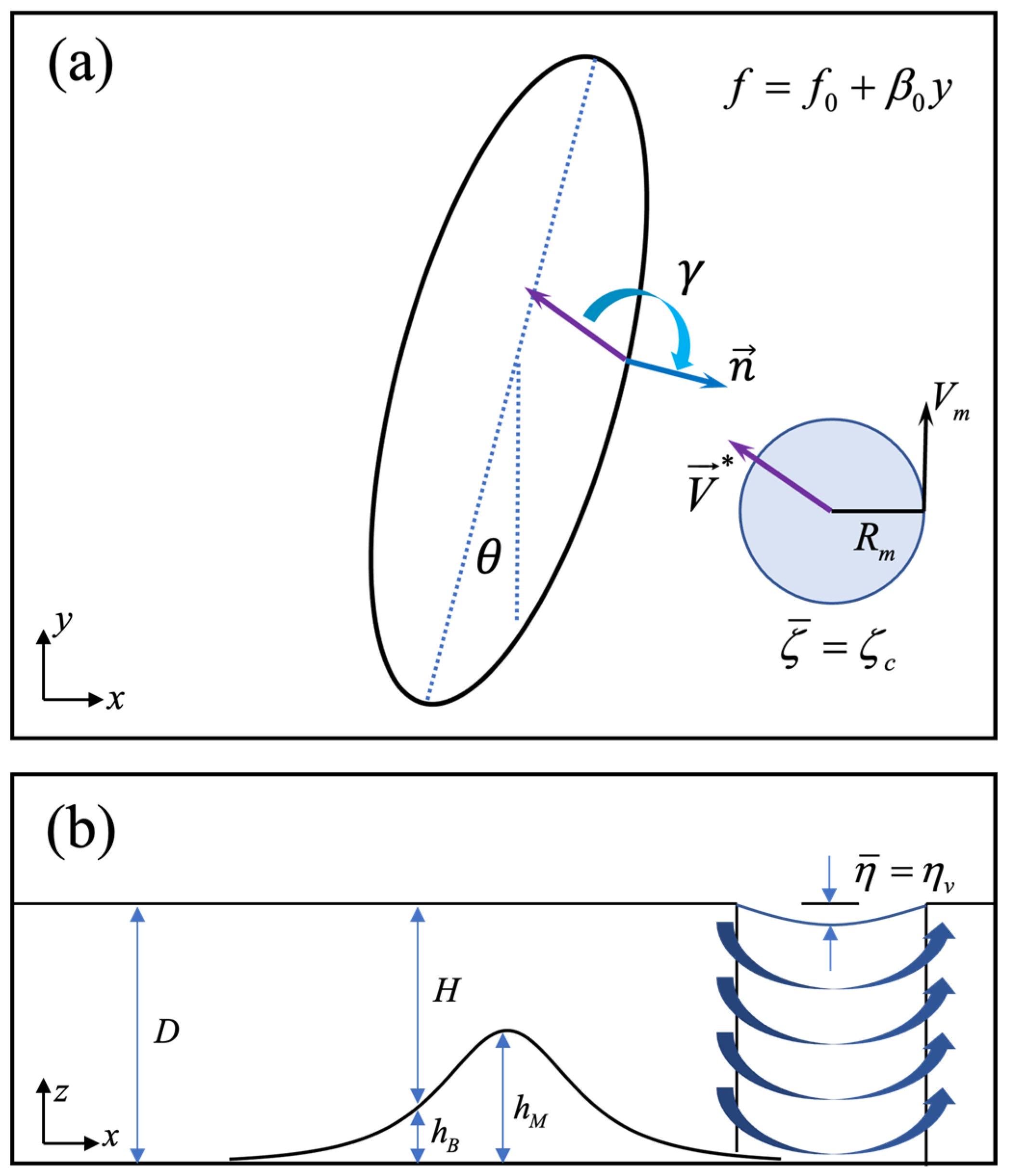
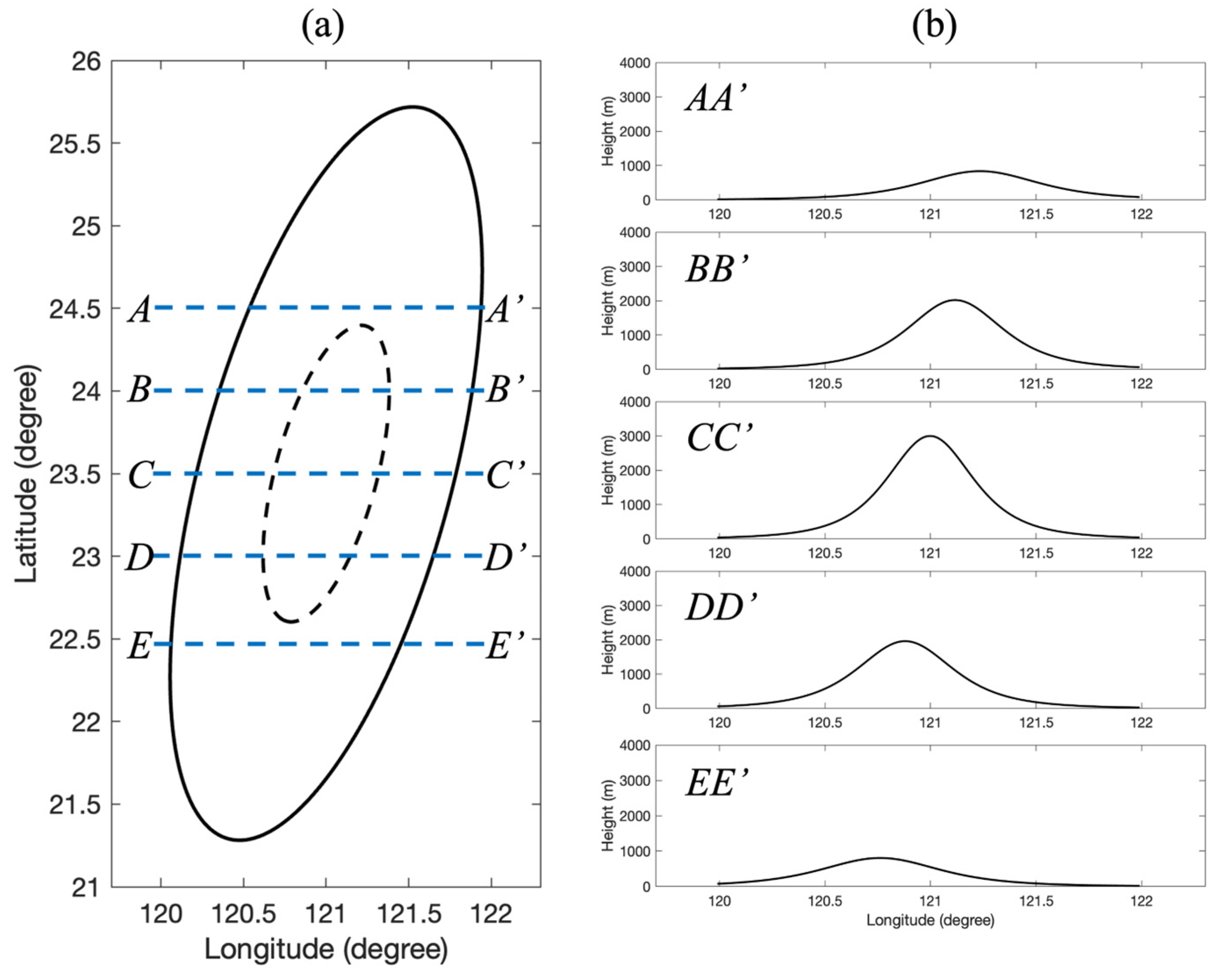


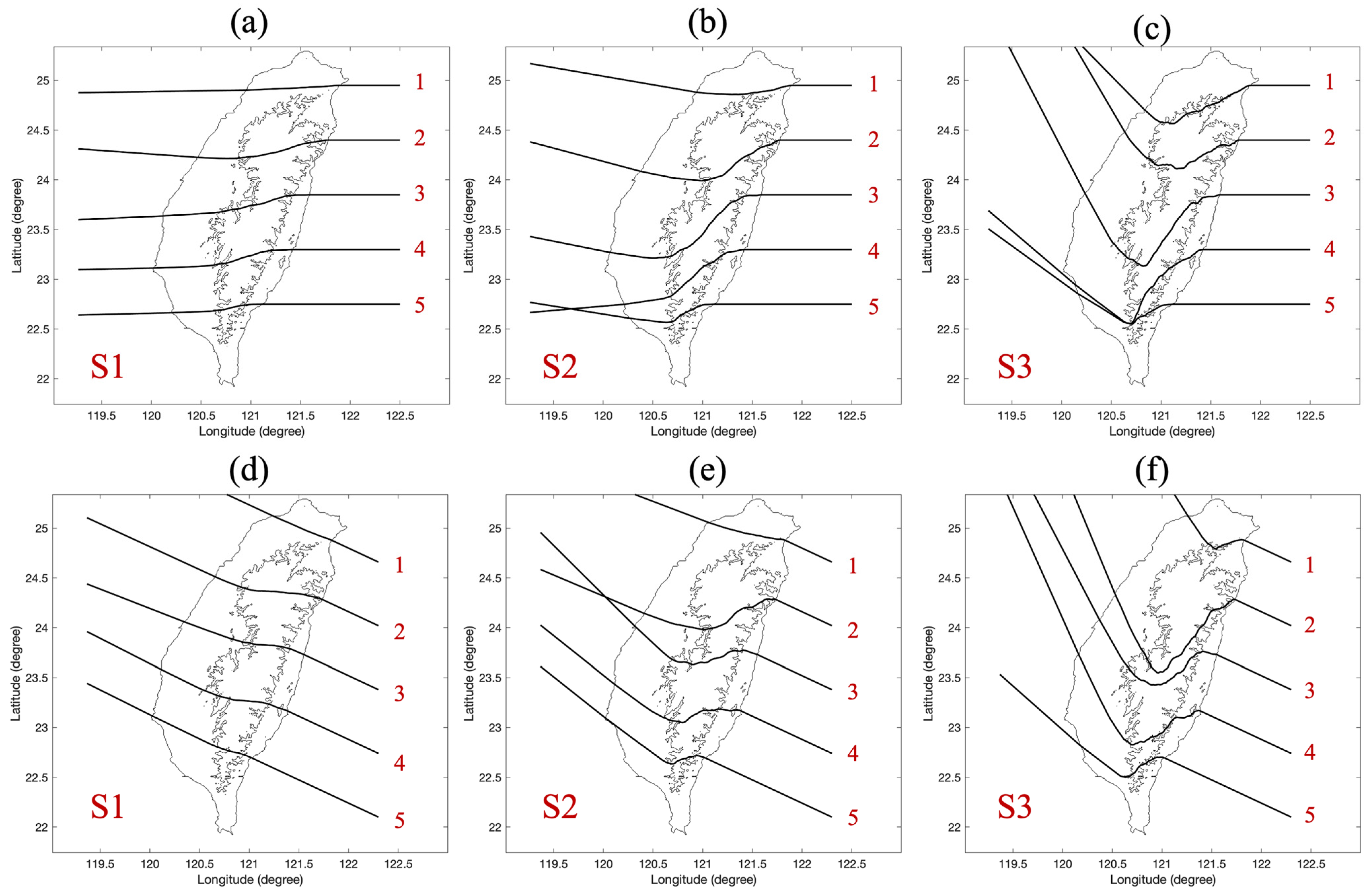
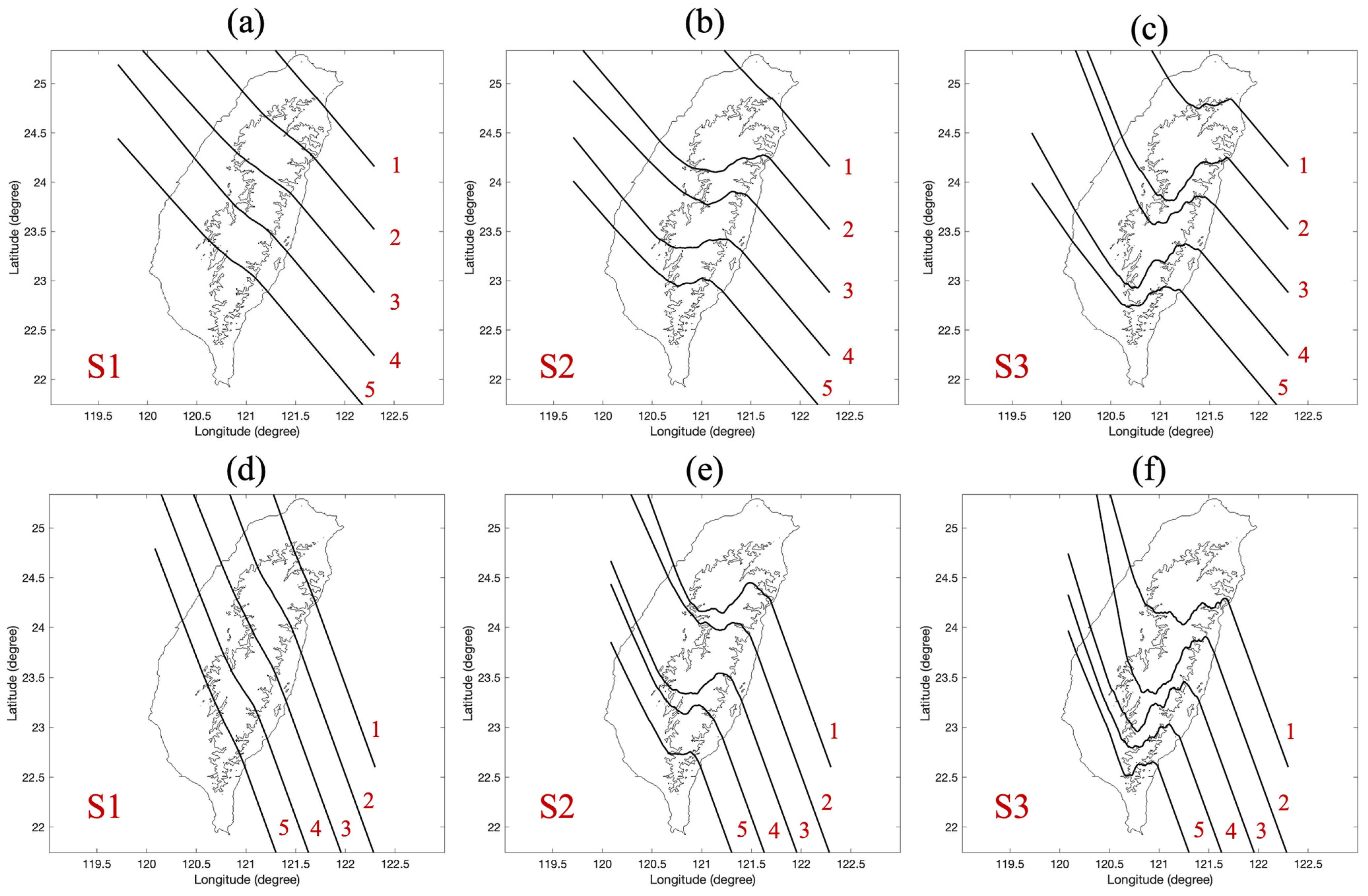
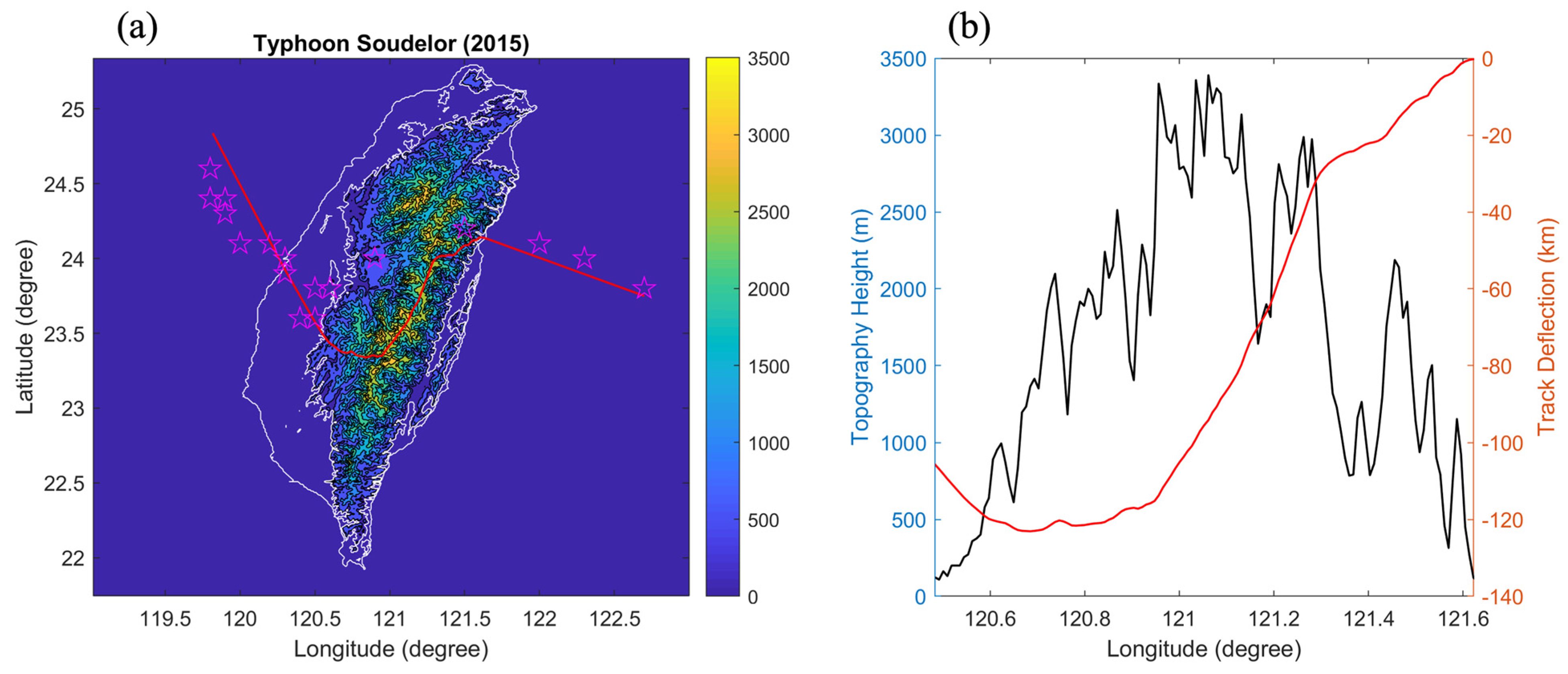
| Mechanism | Description | Research Method | Key References |
|---|---|---|---|
| Orographic Blocking | Occurs when mountain ranges, like Taiwan’s Central Mountain Range, block a typhoon’s lower-level flow, leading to track deflections or slowed movement. Factors such as cyclone intensity, approach angle, and mountain height affect the degree of deflection, with frequent northward or southward shifts observed. | Observational analysis, numerical simulations, idealized modeling, laboratory experiments | [4,7,21,37] |
| Channeling Effect | Describes the acceleration of low-level winds as they are funneled through narrow valleys or gaps between the typhoon center and mountainous terrain, such as Taiwan’s Central Mountain Range. This effect creates a northerly jet on the terrain-facing side of the cyclone, which can influence track deflection, especially contributing to a southward movement as the cyclone approaches the terrain. | Observational studies, idealized modeling | [12,24] |
| Topographic Beta Drift | Based on the “local northwest rule” observed in laboratory and numerical studies, topographic beta drift describes how cyclonic vortices tend to drift northwestward when moving over sloping terrain. This drift resembles the planetary beta effect, with the cyclone exhibiting clockwise movement as it ascends windward slopes and descends leeward slopes. | Laboratory experiments, numerical simulations, theoretical models | [32,37,38,39,40] |
| Vortex Intensity and Structure | Cyclone intensity and structural features, such as core definition and wind radius, affect topographic interactions. Stronger, well-structured cyclones experience more pronounced deflections, often displaying asymmetric flow changes when interacting with terrain like Taiwan’s Central Mountain Range. | Idealized simulations, real-case simulations, sensitivity experiments | [12,17,18,19,25,26,27] |
| Impinging Angle | The angle of a typhoon’s approach to terrain affects track deflection. Shallow angles lead to prolonged interactions and greater deflection, often southward, while steeper angles result in less deviation. | Idealized models, real-case simulations, sensitivity studies | [15,16,24,27,28,29] |
| Terrain-induced Vorticity Effect/Loop Effect | When a cyclone encounters mountainous terrain, it generates additional vorticity due to slopes and irregular topography. This added vorticity can alter the cyclone’s path, often causing deflection or looping near the terrain, as seen around Taiwan’s Central Mountain Range. | Laboratory experiments, numerical simulations, observational analysis | [12,21,22,23,32,37,41] |
| Laboratory Experiments | Laboratory experiments use rotating tanks to simulate cyclonic interactions with terrain, showing predictable deflections. Vortices exhibit clockwise ascent on windward slopes and descent on leeward sides, aligning with the “local northwest rule” for topographic influence. | Rotating tank experiments; numerical simulations | [32,37,41,42,43] |
| Figure | Vortex | ||||||||||
|---|---|---|---|---|---|---|---|---|---|---|---|
| 3(a) | M | 30 | 150 | 0.0004 | 3.7 | 7.3 | 0.082 | 0.016 | 5.15 | 42.8 | 195 |
| 3(b) | M | 30 | 150 | 0.0004 | 3.7 | 7.3 | 0.082 | 0.016 | 5.15 | 42.8 | 170 |
| 3(c) | M | 30 | 150 | 0.0004 | 3.7 | 7.3 | 0.082 | 0.016 | 5.15 | 42.8 | 145 |
| 3(d) | M | 30 | 150 | 0.0004 | 3.7 | 7.3 | 0.082 | 0.016 | 5.15 | 42.8 | 125 |
| 5(a) | S1 | 20 | 200 | 0.0002 | 1.8 | 3.7 | 0.164 | 0.043 | 3.86 | 18.0 | 195 |
| 5(b) | S2 | 30 | 150 | 0.0004 | 3.7 | 7.3 | 0.082 | 0.016 | 5.15 | 42.8 | 195 |
| 5(c) | S3 | 30 | 100 | 0.0006 | 5.5 | 11.0 | 0.055 | 0.007 | 7.72 | 92.4 | 195 |
| 5(d) | S1 | 20 | 200 | 0.0002 | 1.8 | 3.7 | 0.164 | 0.043 | 3.86 | 18.0 | 170 |
| 5(e) | S2 | 30 | 150 | 0.0004 | 3.7 | 7.3 | 0.082 | 0.016 | 5.15 | 42.8 | 170 |
| 5(f) | S3 | 30 | 100 | 0.0006 | 5.5 | 11.0 | 0.055 | 0.007 | 7.72 | 92.4 | 170 |
| 6(a) | S1 | 20 | 200 | 0.0002 | 1.8 | 3.7 | 0.164 | 0.043 | 3.86 | 18.0 | 145 |
| 6(b) | S2 | 30 | 150 | 0.0004 | 3.7 | 7.3 | 0.082 | 0.016 | 5.15 | 42.8 | 145 |
| 6(c) | S3 | 30 | 100 | 0.0006 | 5.5 | 11.0 | 0.055 | 0.007 | 7.72 | 92.4 | 145 |
| 6(d) | S1 | 20 | 200 | 0.0002 | 1.8 | 3.7 | 0.164 | 0.043 | 3.86 | 18.0 | 120 |
| 6(e) | S2 | 30 | 150 | 0.0004 | 3.7 | 7.3 | 0.082 | 0.016 | 5.15 | 42.8 | 120 |
| 6(f) | S3 | 30 | 100 | 0.0006 | 5.5 | 11.0 | 0.055 | 0.007 | 7.72 | 92.4 | 120 |
| 7 | Typhoon Soudelor | 15 | 300 | 0.0042 | 0.9 | 76.8 | 0.427 | 0.128 | 3.35 | 260.3 | 175 |
Disclaimer/Publisher’s Note: The statements, opinions and data contained in all publications are solely those of the individual author(s) and contributor(s) and not of MDPI and/or the editor(s). MDPI and/or the editor(s) disclaim responsibility for any injury to people or property resulting from any ideas, methods, instructions or products referred to in the content. |
© 2024 by the author. Licensee MDPI, Basel, Switzerland. This article is an open access article distributed under the terms and conditions of the Creative Commons Attribution (CC BY) license (https://creativecommons.org/licenses/by/4.0/).
Share and Cite
Chen, H.-C. An Innovative Dynamic Model for Predicting Typhoon Track Deflections over Complex Terrain. Atmosphere 2024, 15, 1372. https://doi.org/10.3390/atmos15111372
Chen H-C. An Innovative Dynamic Model for Predicting Typhoon Track Deflections over Complex Terrain. Atmosphere. 2024; 15(11):1372. https://doi.org/10.3390/atmos15111372
Chicago/Turabian StyleChen, Hung-Cheng. 2024. "An Innovative Dynamic Model for Predicting Typhoon Track Deflections over Complex Terrain" Atmosphere 15, no. 11: 1372. https://doi.org/10.3390/atmos15111372
APA StyleChen, H.-C. (2024). An Innovative Dynamic Model for Predicting Typhoon Track Deflections over Complex Terrain. Atmosphere, 15(11), 1372. https://doi.org/10.3390/atmos15111372








